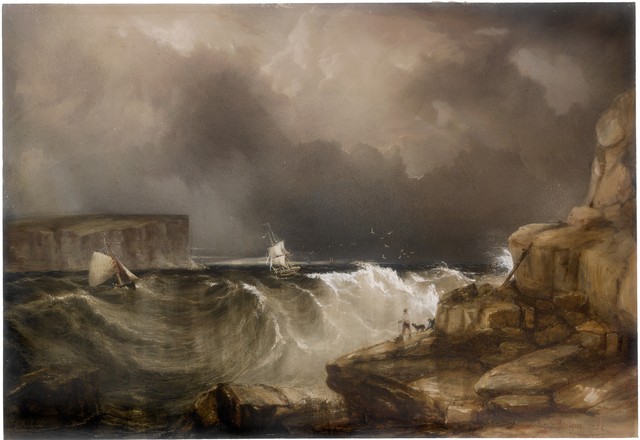Sydney Heads
1854
Watercolour on paper
Presented by Sir William Dixson, 1929
DG*D 18
On arriving in Sydney, Conrad Martens was immediately captivated by the splendour of Sydney Harbour and it became an enduring theme in his work. He produced views from many different vantage points, but those from Sydney’s North Shore were a particular passion. In many of his works he also featured detailed studies of rocks, particularly Sydney sandstone, which he often used to frame his compositions.
This dramatic work is a departure in style for Martens, who is better known for his warm and serene seascape and landscape views. During the 1850s, he produced a series of dark and brooding paintings of wild, stormy seas and ominous skies. Tinged with melancholy, they perhaps reflect the personal toll of the previous decade during which the youngest of his three children died and he faced difficult financial times.
In a letter to his brother Henry in 1850, Martens writes:
‘I have done no oil painting for some time; my painting room is so cold in the winter that I have been obliged to retreat to another room to draw in, but which has no light for painting. I am indeed much disheartened about painting. There is no sale for anything in that way. Small drawings and lithographs and teaching have been of late the only way of raising a little cash.’*
A strong palette
‘The painter
then imitates nature in the main by an abbreviation as it were of what is
before him. He takes the top and the bottom, the two extremes, as strong as his
palette will give him, and many of those numberless middle tones … he very
wisely leaves out.’*
Conrad Martens, 1856
Footnotes
* ‘Lecture upon Landscape Painting’, delivered at the
Australian Library, 21 July 1856
Three things to observe
‘In copying
nature there are three things to be closely observed, viz.; the forms of
objects; their true colour; and the effect as to light and shade, by which will
be understood the expansive look and brightness of a midday sun, the gloom of
an approaching storm, or the sombre hue of twilight …*
Conrad Martens, 1856
Footnotes
* ‘Lecture upon Landscape Painting’, delivered
at the Australian Library, 21 July 1856
His natural element
‘Martens
never learnt to handle oil-colour comfortably; with one of two exceptions, an
even opacity pervades all his work in that medium …Very different is his
accomplishment in water-colour. Here are no hesitations, no misgivings; this is
his natural element … Grace, balance, the feeling for line, a just eye for the
pictorial planes, a delicacy of touch in skies and distances – these are the
characteristics of Martens’s art. His love of nature was untiring.’*
Artist Lionel Lindsay, 1920
Footnotes
* From L Lindsay, Conrad Martens: The Man and his Art, 2nd
edn, 1968, pp 22–23
At his best
‘In his many
works on the theme of Sydney Harbour Martens is seen at his best. One feels
that though necessity obliged him to dissipate his talents in teaching and
recording the settings of the homes of a new landed gentry, there was always in
the background the allurement of the harbour with its rocky foreshores and
wooded promontories.’*
Artist Douglas Dundas, 1968
Footnotes
* From L Lindsay, Conrad Martens: The Man and his Art, 2nd
edn, 1968, p xi
A scientific eye
After
accepting an offer of a three-year voyage to India, Conrad Martens left England
in 1833. At Montevideo, in Uruguay, he transferred to join a scientific
expedition on board the Beagle, replacing
artist Augustus Earle, who had fallen ill. During his two years on the Beagle, Martens developed and widened
his skills in documenting the natural world, and began a lasting friendship
with Charles Darwin. Within six months of arriving in Sydney in 1835, he had
made sketching expeditions to the Illawarra, the Blue Mountains and Broken Bay.



 Back to list
Back to list